History of the building of All Saints' Chilton
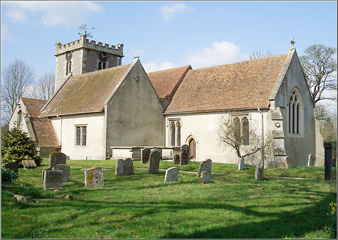
Nave
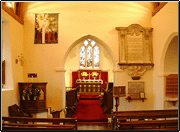 The nave is the oldest part of the church and is believed to have been built between 1160 and 1180. Originally, it would have been lit by small round-headed windows like those in nearby Upton church. The present window in the north wall dates from the 14th century and was restored in 1962 in memory of John and Alice Mary Harris, who died in 1943 and 1945 respectively. To the left of this window is a small trefoiled (three-lobed) niche, which would originally have housed a statue. Further west along this wall is a Norman doorway and the stonework of a former fireplace.
The nave is the oldest part of the church and is believed to have been built between 1160 and 1180. Originally, it would have been lit by small round-headed windows like those in nearby Upton church. The present window in the north wall dates from the 14th century and was restored in 1962 in memory of John and Alice Mary Harris, who died in 1943 and 1945 respectively. To the left of this window is a small trefoiled (three-lobed) niche, which would originally have housed a statue. Further west along this wall is a Norman doorway and the stonework of a former fireplace.
In 1962, the nave roof was condemned and a new high-pitched roof similar to that of the chancel was built after the walls were strengthened. It was during this work that the blocked north doorway was uncovered. Also at this time, a recess approximately 18 inches deep was discovered within the wall behind the pulpit. This may have contained a stair to give access to the rood screen. According to William Hewett, a surgeon of East Ilsley and author of a history of the villages in the Compton Hundred published in 1844, this was "gaudily painted". A hole has been left to show the extent of the evidence found to date. The two-bay arcade separating the nave from the south aisle dates from the early 13th century. The pointed arches are single chamfered and supported by a central column with a moulded capital and base. The responds are chamfered and at the springing are moulded abaci. To the west of the arcade on the south wall of the nave is a square-headed window of two cinque-foiled (five-lobed) lights.
South Aisle
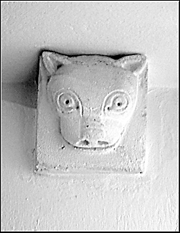 The south aisle, which dates from the 13th century, is lit by south and west windows. The window in the west wall is a 14th century square-headed window of two trefoiled ogee lights, while in the south wall is a 15th century window of two square-headed lights. Adjacent to the south window at the top on the left hand side can be seen a carved headstop known as "The bear". This is one of two faces, apparently of 12th century origin, the other being "The lady with plaits", which used to reside on the sill of the north window in the nave. However, following the theft of "The lady", "The bear" was cemented into its present location to prevent it from suffering a similar fate.
The south aisle, which dates from the 13th century, is lit by south and west windows. The window in the west wall is a 14th century square-headed window of two trefoiled ogee lights, while in the south wall is a 15th century window of two square-headed lights. Adjacent to the south window at the top on the left hand side can be seen a carved headstop known as "The bear". This is one of two faces, apparently of 12th century origin, the other being "The lady with plaits", which used to reside on the sill of the north window in the nave. However, following the theft of "The lady", "The bear" was cemented into its present location to prevent it from suffering a similar fate.
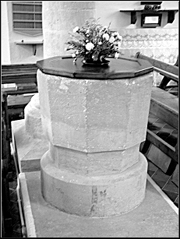 The font dates from the 12th century and is unusual in being nine-sided; the base upon which it stands is modern. It is situated directly in line with the north and south doors. According to ancient superstition, it was placed in this position so that the "evil" brought in with the unbaptised child might be swept out through the north door. An image of St Christopher, regarded as a source of comfort to travellers and those in difficulties, was often situated above this door in many churches. However, no such trace has been found at Chilton.
The font dates from the 12th century and is unusual in being nine-sided; the base upon which it stands is modern. It is situated directly in line with the north and south doors. According to ancient superstition, it was placed in this position so that the "evil" brought in with the unbaptised child might be swept out through the north door. An image of St Christopher, regarded as a source of comfort to travellers and those in difficulties, was often situated above this door in many churches. However, no such trace has been found at Chilton.
Chancel
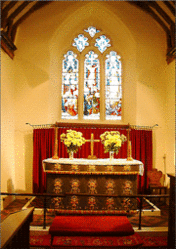 The chancel was built in the late 13th or early 14th century. On the external walls there are two diagonal buttresses at each corner of the east wall, with another against the north wall. Inside, the chancel is entered through the unmoulded pointed chancel arch, which dates from about 1300. On the south side of the chancel arch is the consecration cross, usually inscribed by the mason for the bishop's consecration ceremony. Within the chancel itself in the south wall, separating the two windows, can be seen a small arched doorway known as the "priest's door".
The chancel was built in the late 13th or early 14th century. On the external walls there are two diagonal buttresses at each corner of the east wall, with another against the north wall. Inside, the chancel is entered through the unmoulded pointed chancel arch, which dates from about 1300. On the south side of the chancel arch is the consecration cross, usually inscribed by the mason for the bishop's consecration ceremony. Within the chancel itself in the south wall, separating the two windows, can be seen a small arched doorway known as the "priest's door".
There are five windows in the chancel: the east window and two in both north and south walls. In the north wall are two single trefoiled ogee lights, while in the south wall are two late 14th century square-headed windows with cinquefoil lights. The east window also dates from this period; the exterior stonework was restored in 1998. The glass was installed in memory of Edward Morland Chaplin (1831-1877), rector of Chilton from 1857 until his death. It was designed by J.F. Bentley, the architect of Westminster Cathedral, and executed by Nathaniel Westlake.
Monuments
On the north wall of the chancel is an 18th century memorial to Richard Knapp, a Bencher and Reader of the Inner Temple, London, who died in 1716. The Knapps enjoyed a long association with Berkshire, having lived there since the 14th century. One ancestor, John Knapp, was mayor of Bristol in 1380. A descendant, Francis Knapp, later became Dean of Killala in County Mayo, Ireland. He was buried in Chilton churchyard on 1st June 1717. The Knapps bought Latton Place (now Place Farm) from the Latton family in 1603 and held the manor until it passed to the Morlands in the 19th century. In the nave is a similar memorial (in Latin) to Adam Head, his wife and their three children.
Hassocks
The hassocks were made by ladies of the church between 1965 and 1980 and the designs reflect various aspects of the locality. These include orchids, horses, farming, science, the arms of the diocese, Berkshire, the Atomic Energy Research Establishment and several RAF squadrons stationed at RAF Harwell during World War Two. The altar step kneelers were designed by Seton McConnell in 1991 and stitched by members of the church. The design was inspired by the Romanesque carving of the apostles in the porch of Malmesbury Abbey.
Registers
The baptism registers date from 1584, the marriage registers from 1694 and burial registers from 1667, although those covering the period 1812-1960 have not survived. With the exception of the most up-to-date registers still in use, they can be found in the Berkshire Record Office at Reading. Chilton was part of Berkshire until the local government reorganisation of 1974, whereupon it became part of Oxfordshire. Other records that have survived include an overseer's accounts book covering the period 1658 - 1720. The job of the overseer was to look after the funds for the relief of the poor; in 1658, a total of £8 17s 9d was disbursed for this purpose. In addition, a churchwarden's accounts book (1722-1792) has also survived. Examples of entries from this period include: "Wine and bread at Easter 3s 2d", "3 bell ropes 7s", "For a church bible and a horses stabling & hay £2 9s 2d" and "Communion Cloth £1 2s 6d".
Plate
The church possesses a silver chalice and a paten. The chalice, which has been tentatively dated to 1678, has been stamped with the letters "BP", which could be the mark of Benjamin Payne. It appears that the rim has undergone a repair: this is supported by an entry in the churchwarden's accounts book for 1774, which reads: "For mendin of the Silver Cup 1s". The silver paten, upon which a faint mark "M&W London" can be seen, also dates from this time. The church formerly owned at least three other pieces of silverware, but these were apparently lost during the early 20th century
Churchyard
The churchyard contains several historic gravestones dating back more than 200 years, some of which have unusually poetic inscriptions.
On the south side of the chancel, close to the path, is a monument to the Brooker family. The inscription reads: "Here lyeth Mr John Brooker, buried 1551 with his sons of the same name in a direct line unto the fourth generation, the last of which was buried 1671, and since his brother Mr Thomas Brooker". At one time this was the oldest surviving outdoor legible memorial in the diocese, and although it was touched up in 1975 has deteriorated in recent years.
Close to the north wall of the chancel is a flat slab inscribed to the memory of George Goddard, who was killed in a riding accident in 1794, aged 18. The Goddards were a long-established Chilton family, and probably lived in the house of that name halfway down Church Hill. The earliest reference to them is an entry in the baptism record for 1616. The slab contains the following epitaph:
In health I went away from home,
but did with life no more return
My horse he stumbled and fell down
And threw me lifeless to the ground
Short was my life, my pain the less
God took me home as He thought best.
Another lavishly carved headstone, now almost illegible, lies at the east end of the chancel. This marks the grave of Mary Holmes, who was buried on 1st March 1767. It includes these words:
Indulgent wife, a friend sincere
She's gone to rest we need not fear,
Her time was short,
God set her free,
Her blest Redeemer call'd for she.
Lych gate
The present lych gate was erected in memory of Rev. Anthony Thomas Morland, who died in 1920, and was restored in 2004. "Lych" is the old English word for corpse, and its function was to enable the coffin bearers to rest while waiting for the funeral procession to assemble behind.